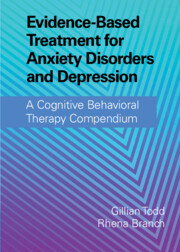 Evidence-Based Treatment for Anxiety Disorders and Depression
Evidence-Based Treatment for Anxiety Disorders and Depression from Part Six - Specialist Applications of Cognitive Behavioral Therapy for Anxiety Disorders and Depression
Published online by Cambridge University Press: 06 January 2022
Cognitive behavior therapy is the treatment of choice for a wide range of mental health difficulties in the United Kingdom, Europe, North America, Australia, and New Zealand, but research evidence suggests that access to this therapy and clinical outcomes for patients is worse for patients from Black and minority ethnic (BAME) backgrounds compared with patients from white majority communities in most of these countries. This chapter looks at the changes that services and therapists can make to adapt the way that they work to ensure that access and outcomes for minority communities improve. Some of these changes are modest, such as ensuring that therapists acknowledge ethnic and cultural differences; however, some might need more extensive adaptation such as developing family system maps that take into account the beliefs, practices, and migration histories of different family members or understanding how spiritual beliefs can be incorporated into treatment plans. This chapter provides a practical and accessible framework for adaptation and suggests further reading to support the development of therapist skills in trans-cultural assessment and treatment of mental health problems when working with patients from BAME communities.
To save this book to your Kindle, first ensure [email protected] is added to your Approved Personal Document E-mail List under your Personal Document Settings on the Manage Your Content and Devices page of your Amazon account. Then enter the ‘name’ part of your Kindle email address below. Find out more about saving to your Kindle.
Note you can select to save to either the @free.kindle.com or @kindle.com variations. ‘@free.kindle.com’ emails are free but can only be saved to your device when it is connected to wi-fi. ‘@kindle.com’ emails can be delivered even when you are not connected to wi-fi, but note that service fees apply.
Find out more about the Kindle Personal Document Service.
To save content items to your account, please confirm that you agree to abide by our usage policies. If this is the first time you use this feature, you will be asked to authorise Cambridge Core to connect with your account. Find out more about saving content to Dropbox.
To save content items to your account, please confirm that you agree to abide by our usage policies. If this is the first time you use this feature, you will be asked to authorise Cambridge Core to connect with your account. Find out more about saving content to Google Drive.